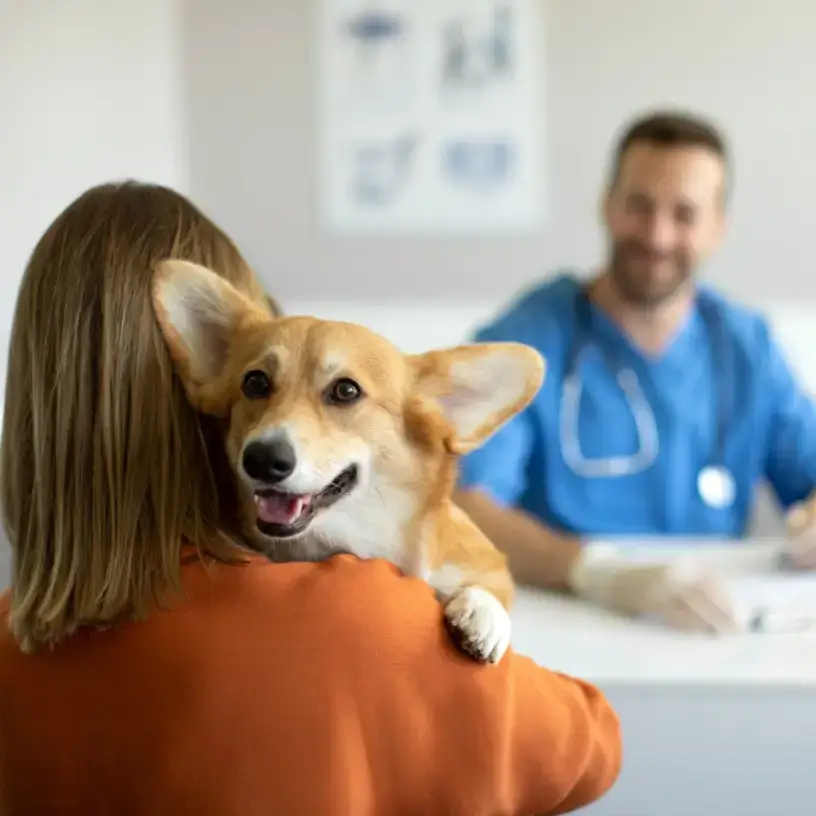Home / Compare Pet Insurance / Cost of dog X-rays




Key takeaways
- Dog X-rays are an important tool veterinarians rely on to diagnose various health issues, ranging from bone fractures to internal concerns.
- The X-ray process usually takes just a few minutes, though your dog might need sedation depending on their temperament and the complexity of the procedure.
- Having pet insurance can bring peace of mind to pet parents and help manage the cost of procedures like X-rays, making it a worthwhile option for many dog owners in Australia.
How much does a dog X-ray cost in Australia?
 X-rays, also known as radiography, play a vital role in diagnosing a dog’s health, allowing animal hospitals across Australia to see the dog’s internal structures and provide an accurate diagnosis, from broken bones to internal organ problems.1
X-rays, also known as radiography, play a vital role in diagnosing a dog’s health, allowing animal hospitals across Australia to see the dog’s internal structures and provide an accurate diagnosis, from broken bones to internal organ problems.1
The price of a dog X-ray can vary depending on the clinic, location and the complexity of the procedure. The cost will rise if your dog needs multiple views or a more detailed examination.
Note that the cost of an X-ray usually covers just the X-ray itself and excludes any veterinary care, treatment plans or follow-up care. It’s a good idea to ask your vet about the potential cost upfront so that you can get a clear idea of the total cost based on your dog’s condition.
- Standard X-ray: This is typically used to examine the skeletal system for fractures, arthritis or joint problems.2
- Contrast X-rays: These are used to highlight soft tissues or identify things like foreign objects in the digestive system or organ abnormalities.3
- Dental X-rays: These X-rays are focused on the dog’s teeth and gums, checking for issues like tooth decay or fractures.1
- Multiple views: If a more comprehensive picture is needed, the vet may take several X-rays from different angles to provide a clearer diagnosis. This adds to the cost as the procedure becomes more complex.3
- Specialist X-rays: Some veterinary clinics with advanced imaging equipment or specialised radiologists may charge more for their services.3
What are dog X-rays used for?
X-rays are incredibly helpful in diagnosing and monitoring various health issues in dogs. Here are some of the primary uses for dog X-rays:3
- Bone fractures: X-rays are commonly used to check for broken bones, dislocations and joint problems, guiding vets in determining the best treatment options.
- Arthritis and joint issues: Conditions like elbow and hip dysplasia and other ligament issues common in certain breeds can be diagnosed through X-rays.
- Tumors and cancers: X-rays help identify abnormal growths, such as bladder stones, abscesses or tumours, and can also help determine if cancer has spread.
- Heart and lung conditions: X-rays can assess the heart’s size and shape and detect heart disease or lung infections.
- Ingestion of foreign objects: If your dog swallows something harmful or obstructive, an X-ray will help locate the blockage and identify the foreign bodies.
- Pregnancy: X-rays are used to monitor the health of a pregnant dog, especially to check the number and position of her puppies.
- Spinal issues: X-rays are often used to assess back problems, such as disc disease or spinal fractures.
How long does it take to do an X-ray on a dog?
Generally, the actual use of the X-ray machine only takes about 5 to 15 minutes.4 However, the whole process, including getting your dog into the correct position and possibly administering sedation, can take longer.
If your dog requires multiple images or the radiologist needs extra time to position them, the appointment could last longer than just the X-ray itself. After the images are taken, the vet will need time to review the radiographs and interpret your pet’s condition.
Are dogs sedated for X-rays?
Whether your dog will need sedation depends on a few factors, including your dog’s temperament and the complexity of the X-ray procedure. Sedation might be required in the following situations:2
- Uncooperative dogs: If your dog is anxious, stressed or in pain, they might have trouble staying still for the X-ray. Sedation helps ensure they remain calm and still for better, clearer images.
- Complex procedures: When multiple images are needed or a clear image is crucial, sedation can reduce movement and ensure high-quality results.
- Small or highly anxious dogs: Smaller dogs, or those particularly nervous, may not tolerate being held still, so sedation could be necessary.
If your dog is calm and cooperative, sedation might not be needed, and the X-ray can be done with minimal restraint. Your vet will assess your dog’s behaviour and decide if sedation is the best option.
Risks and safety of dogs during X-rays
Although X-rays are a valuable diagnostic tool, there are some safety considerations:3
- Radiation exposure: X-ray technologies use radiation, but the amount of radiation is usually very low, and the risks to your dog are minimal. Vets take precautions to expose only the necessary area of your dog’s body.
- Pregnancy considerations: If your dog is pregnant, there are some risks to the puppies from the radiation. Vets will avoid using X-rays on pregnant dogs unless necessary and may suggest alternatives like ultrasounds.
- Sedation risks: If your dog requires sedation, there are some inherent risks, especially if your dog has pre-existing health conditions. Vets will assess your dog’s health before administering sedation to ensure safety.
Preparing your dog for an X-ray
To ensure a smooth procedure and a clear X-ray scan, pet parents can take a few steps to help their furry friend feel more comfortable.3
Fasting
If the X-ray is focused on the digestive system (e.g. checking for foreign objects or digestive problems), your vet might recommend fasting your dog for a few hours beforehand.
This helps ensure there are no food-related obstructions in the X-ray images. Generally, adult dogs should fast for about 6-12 hours, but puppies may not need to fast as long.
Calming your dog
Some dogs can get anxious at the vet. To ease their stress, you might consider:
- Depending on your dog’s condition, giving your dog a walk or playtime before the visit to burn off extra energy.
- Using calming products like pheromone sprays or natural remedies (such as lavender or chamomile), under vet guidance.
- Bring a familiar toy or blanket to help comfort your dog during the visit.
Medical history
If your dog has any ongoing health issues or past surgeries, bring their medical history to the appointment. This information helps your vet make the right decisions during the X-ray.
Is pet insurance worth it?
 Pet insurance can be a real lifesaver when it comes to covering unexpected veterinary expenses, including diagnostic procedures like X-rays. It can help offset the costs of expensive treatments and tests, making it easier to choose advanced options like X-rays or MRIs when needed.
Pet insurance can be a real lifesaver when it comes to covering unexpected veterinary expenses, including diagnostic procedures like X-rays. It can help offset the costs of expensive treatments and tests, making it easier to choose advanced options like X-rays or MRIs when needed.
If your dog is at a higher risk for injuries or health issues, having pet insurance can significantly ease the financial strain of unforeseen veterinary bills, including diagnostic tests. It can also bring peace of mind, knowing that you have coverage for emergencies and illnesses, so you can focus on your dog’s well-being instead of worrying about costs. Many pet insurance policies in Australia cover treatment costs for accidents and illnesses, and include diagnostic imaging like X-rays.
Be sure to review the Product Disclosure Statement (PDS) and the Target Market Determination (TMD) to understand what’s covered in your insurance policy and ensure it’s the right fit for your pet.
Meet our pet insurance expert, Adrian Taylor
As a General Insurance expert with over 13 years’ experience in financial services, Adrian Taylor knows that dogs and cats get themselves into all sorts of mischief. One part of Adrian’s work is to help empower consumers to understand how pet insurance can help save them from exorbitant vet bills when their pet gets injured or falls ill.
Want to know more about pet insurance?
1 Sydney Veterinary Emergency and Specialist (SVES). How Modern X-rays, Scans and Ultrasounds Can Save Your Pet’s Life. Accessed March 2025.
2 Greencross Vets. Digital X-ray. Accessed March 2025.
3 PetMD. X-Rays for dogs. Accessed March 2025.
4 Veterinary Specialty & Emergency Center. X-rays for dogs: What to expect. Accessed March 2025.

